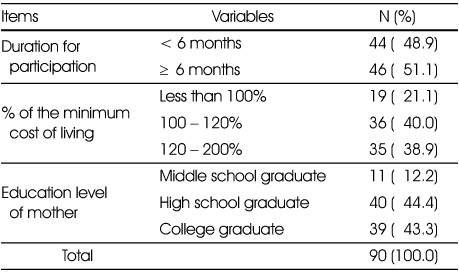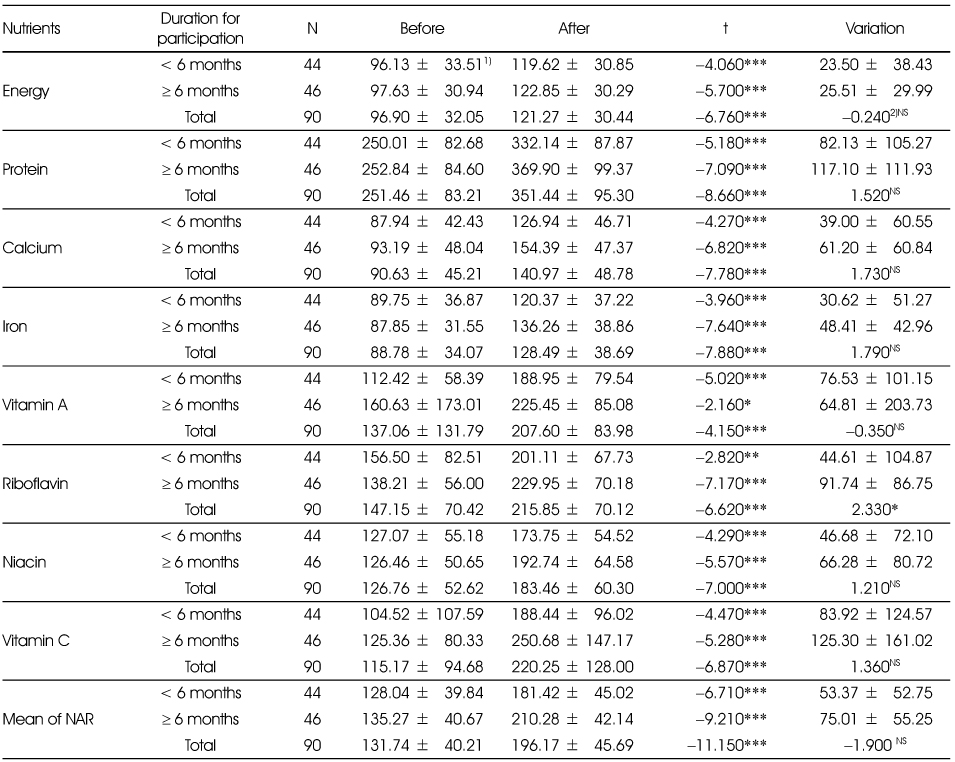Articles
- Page Path
- HOME > Korean J Community Nutr > Volume 18(1); 2013 > Article
-
Original Article
- The Effect of NutriPlus Program among 1-5 Year Children in Daejeon Area - The Improvement in Nutritional Status of Children and Nutrition Knowledge and Attitude of Parents -
- Seon-A Park, Eun-Young Yoon
-
Korean Journal of Community Nutrition 2013;18(1):1-10.
DOI: https://doi.org/10.5720/kjcn.2013.18.1.1
Published online: February 28, 2013
Daedeok Health Center, Daejeon, Korea.
1Department of Food & Nutrition, Daejeon University, Daejeon, Korea.
- Corresponding author: Eun-young Yoon, Department of Food & Nutrition, Daejeon University, Yongwoon-dong, Dong-gu, Daejeon 300-716, Korea. Tel: (042) 280-2471, Fax: (042) 280-2468, yeyoung@dju.kr
Copyright © 2013 The Korean Society of Community Nutrition
- 1,432 Views
- 5 Download
- 39 Crossref
Figure & Data
REFERENCES
Citations

- Development and evaluation of a nutrition education program for housewives to reduce sodium intake: application of the social cognitive theory and a transtheoretical model
Sohyun Ahn, Jong-Sook Kwon, Kyungmin Kim, Hye-Kyeong Kim
Journal of Nutrition and Health.2022; 55(1): 174. CrossRef - Evaluation of the dietary quality and nutritional status of elderly people using the Nutrition Quotient for Elderly (NQ-E) in Seoul
Sun-Wook Ham, Kyung-Hee Kim
Journal of Nutrition and Health.2020; 53(1): 68. CrossRef - Comparison of the sodium content of Korean soup-based dishes prepared at home, restaurants, and schools in Seoul
Yanghee Park, Jihyun Yoon, Sang-Jin Chung
Journal of Nutrition and Health.2020; 53(6): 663. CrossRef - The food and nutrient intakes from daily processed food in Korean adults: based on the 6th Korea National Health and Nutrition Examination Survey data (2013 ~ 2015)
Ae Wha Ha, Woo Kyoung Kim
Journal of Nutrition and Health.2019; 52(5): 422. CrossRef - Study on the correlation between nutrition knowledge, dietary attitudes of guardians, and nutritional status of infants and toddlers - Nutrition-Plus program in Jeonju
Eun Young Song, Jeong Ok Rho
Journal of Nutrition and Health.2018; 51(3): 242. CrossRef - A Study on the Relationship between Metabolic Syndrome and Sodium among the Clients of the General Medical Examination Center
Mi-Jung Yun, Young-Mi Kim
Journal of the East Asian Society of Dietary Life.2018; 28(6): 404. CrossRef - Effect of a public health center-based nutrition education program for hypertension in women older than 50 years of age
Seoyun Park, Jong-Sook Kwon, Hye-Kyeong Kim
Journal of Nutrition and Health.2018; 51(3): 228. CrossRef - Effects of a Practice Program for Low-Salt Meals on Infant Foodservices : Focusing on Infant Foodservices registered in Center for Children's Foodservice Management in Busan Metropolitan City
Chae-Young Jo, Jin-Suk Han
Journal of the East Asian Society of Dietary Life.2018; 28(1): 66. CrossRef - Relationship of sodium consumption with obesity in Korean adults based on Korea National Health and Nutrition Examination Survey 2010~2014
Se Young Cheon, Hye Won Wang, Hwa Jung Lee, Kyung Mi Hwang, Hae Seong Yoon, Yoon Jung Kang
Journal of Nutrition and Health.2017; 50(1): 64. CrossRef - Evaluation of the sodium intake reduction plan for a local government and evidence-based reestablishment of objectives: Case of the Seoul Metropolitan Government
A-Hyun Lim, Ji-Yun Hwang, Kirang Kim
Journal of Nutrition and Health.2017; 50(6): 664. CrossRef - Correlation analysis of sodium-related knowledge, dietary behavior, attitudes towards a low-salt diet and meal attitude guidance for elementary school teachers in Jeonbuk area
Hyun Ok Moon, Jeong Ok Rho
Journal of Nutrition and Health.2017; 50(2): 180. CrossRef - Household Food Insecurity Is Associated with Adverse Mental Health Indicators and Lower Quality of Life among Koreans: Results from the Korea National Health and Nutrition Examination Survey 2012–2013
Hye-Kyung Chung, Oh Kim, So Kwak, Yoonsu Cho, Kyong Lee, Min-Jeong Shin
Nutrients.2016; 8(12): 819. CrossRef - Salt Preference and Sodium Intake among Pregnant Women
Mi Jeung Im, Dong Sook Cho
Korean Journal of Women Health Nursing.2016; 22(4): 297. CrossRef - Study on the Sodium Intake Knowledge and Practices for Reducing Sodium Intake in Soldiers
Ji Min Hwang, Sung Hee Min, Min June Lee
Journal of the East Asian Society of Dietary Life.2016; 26(6): 550. CrossRef - A Comparison of Sources of Sodium and Potassium Intake by Gender, Age and Regions in Koreans: Korea National Health and Nutrition Examination Survey (KNHANES) 2010-2012
Yang-hee Park, Sang-Jin Chung
Korean Journal of Community Nutrition.2016; 21(6): 558. CrossRef - A Comparative Study on the Awareness of Health Risks and the Risk Reduction Measures Related to Sodium Intake between Female and Male University Students in Busan and Gyeongnam: An Application of Protection Motivation Theory
Soo-Hyun Jang, Eunju Yoon
Korean Journal of Food & Cookery Science.2016; 32(1): 136. CrossRef - Study on Sodium Contents of Kindergarten Lunch Meals in Gyeoungsangbuk-do Area
Dan-Bi Song, Kyung-A Lee
Korean Journal of Food & Cookery Science.2016; 32(5): 648. CrossRef - Study on Energy and Nutrient Intake and Food Preference of the Elderly in Care Facilities
Jong-Sook Kwon, Seung Hee Lee, Kang Min Lee, Yoonna Lee
Korean Journal of Community Nutrition.2016; 21(2): 200. CrossRef - Relationship between thresholds and self-assessed preference for saltiness and sodium intake in young women
Eugene Shim, Yoon Jung Yang, Yoon Kyoun Yang
Journal of Nutrition and Health.2016; 49(2): 88. CrossRef - Healthy eating exploratory program for the elderly: Low salt intake in congregate meal service
Sunhee Seo, O.Y. Kim, J. Ahn
The Journal of nutrition, health and aging.2016; 20(3): 316. CrossRef - Nutrition Knowledge, Dietary Attitude, and Dietary Behavior Related to Salt According to the Dietary Lifestyle Groups
Hei-Ryeo Yoon, Nam-E Kang, Juhyeon Kim
Korean Journal of Food & Cookery Science.2016; 32(3): 333. CrossRef - Differences in Sodium-Intake Related Dietary Behaviors and Correlation Analysis According to Salty Taste Preference of University Students in Busan Area
Min-Ji Kang, Ki-Bo Choi, Eun-Soon Lyu
Korean journal of food and cookery science.2015; 31(4): 477. CrossRef - The Cost-Benefit Analysis of the NutriPlus Program in Daejeon Dong-gu Health Center
Hyun Ju Kim, Sung Han Kim
The Korean Journal of Food And Nutrition.2015; 28(4): 717. CrossRef - A Comparison of Salty Taste Assessment, Dietary Attitude and Dietary Behavior among Adult and Senior Women by Region and by Age in Korea
Lin Jiang, Yun-Young Jung, Hyung-Sook Kim, Gi-Seon Nam, Jin-Sook Yun, Jong-Wook Kim, Yeon-Kyung Lee
Korean Journal of Community Nutrition.2015; 20(2): 109. CrossRef - Evaluation of Consumer Nutrition Education Program to Reduce Sodium Intake Based on Social Cognitive Theory
So-Hyun Ahn, Jong Sook Kwon, Kyung Min Kim, Jin-Sook Yoon, Hye-Kyeong Kim
Korean Journal of Community Nutrition.2015; 20(6): 433. CrossRef - A Study on Sodium-related Dietary Attitude and Behaviors According to Sodium-related Nutrition Knowledge of University Students
Mi-Hyun Kim, Jee-Young Yeon, Jong Wook Kim, Jae-Eon Byun, So-Young Bu, Mi-Kyeong Choi, Yun-Jung Bae
Korean Journal of Community Nutrition.2015; 20(5): 327. CrossRef - Nutrition Label Use and Its Relation to Dietary Intake among Chronic Disease Patients in Korea: Results from the 2008-2009 Fourth Korean National Health and Nutrition Examination Survey (KNHANES-IV)
Seung Guk Park, Hyeon Ju Kim, Young-Min Kwon, Mi Hee Kong
Korean Journal of Health Promotion.2014; 14(4): 131. CrossRef - The Effectiveness of Na Reduction Program for Cook in Child-care Center: Focus on Self-reevaluation and Strengthen Consciousness
Hyewon Shin, Youngmee Lee
Korean Journal of Community Nutrition.2014; 19(5): 425. CrossRef - Sodium Related Recognition, Dietary Attitude and Education Needs of Dietitians Working at Customized Home Visiting Health Service
Yun-Jeong Mo, Sook-Bae Kim
Korean Journal of Community Nutrition.2014; 19(6): 558. CrossRef - The Effects of Low-sodium Diet Education Program on Dietary Habits, Diet Quality and Obesity Index in Overweight and Obese Middle-aged Women
Soo Bin Jeong, Seoyun Park, Sohyun Ahn, Jin Nam Kim, Hye-Kyeong Kim
Korean Journal of Community Nutrition.2014; 19(6): 513. CrossRef - Blood Pressure, Sodium Intake and Dietary Behavior Changes by Session Attendance on Salt Reduction Education Program for Pre-hypertensive Adults in a Public Health Center
Eun-Jin Jung, Jong-Sook Kwon, So-Hyun Ahn, Sook Mee Son
Korean Journal of Community Nutrition.2013; 18(6): 626. CrossRef - Dietary Behaviors Related to Metabolic Syndrome in Korean Adults
Jinkyung Park, Sanghui Kweon, Yangha Kim, Myoung-Jin Jang, Kyungwon Oh
Korean Journal of Community Nutrition.2012; 17(5): 664. CrossRef - A Comparison of Salty Taste Assessments and Dietary Attitudes and Dietary Behaviors Associated with High-Salt Diets in Four Regions in Korea
Hyun-Hee Kim, Yun-Young Jung, Yeon-Kyung Lee
Korean Journal of Community Nutrition.2012; 17(1): 38. CrossRef - Development of Nutrition Education Program for Hypertension Based on Health Belief Model, Applying Focus Group Interview
Seoyun Park, Jong-Sook Kwon, Cho-il Kim, Yoonna Lee, Hye-Kyeong Kim
Korean Journal of Community Nutrition.2012; 17(5): 623. CrossRef - Study on the Eating Habits and Practicability of Guidelines for Reducing Sodium Intake according to the Stage of Change in Housewives
So-Hyun Ahn, Jong-Sook Kwon, Kyungmin Kim, Jin-Sook Yoon, Baeg-Won Kang, Jong wook Kim, Seok Heo, Hea-Young Cho, Hye-Kyeong Kim
Korean Journal of Community Nutrition.2012; 17(6): 724. CrossRef - Effects of Nutritional Education Practice Program for Cardiocerebrovascular High-risk Group at the Education Information Center
Hang Me Nam, Seung Hee Woo, Young Ji Cho, Yun Jung Choi, Su Yeon Back, So Yeon Yoon, Jin Young Lee, Jung-Jeung Lee, Hye Jin Lee
Korean Journal of Community Nutrition.2011; 16(5): 580. CrossRef - The Effects of a Worksite On-line Health Education Program on Metabolic Syndrome Risk Factors and Nutrient Intakes of Male Workers
Ji-Yeon Kang, Sang-Woon Cho, Ji-Young Lee, Sook-Hee Sung, Yoo-Kyoung Park, Yun-Mi Paek, Tae-In Choi
The Korean Journal of Nutrition.2010; 43(1): 57. CrossRef - Effect of a 6-month Low Sodium Diet on the Salt Taste Perception and Pleasantness, Blood Pressure and the Urinary Sodium Excretion in Female College Students
Soon-Ok Chang
The Korean Journal of Nutrition.2010; 43(5): 433. CrossRef - Analysis by Delphi Survey of a Performance Evaluation Index for a Salt Reduction Project
Hyun-Hee Kim, Eun-Kyung Shin, Hye-Jin Lee, Nan-Hee Lee, Byung-Yeol Chun, Moon-Young Ahn, Yeon-Kyung Lee
The Korean Journal of Nutrition.2009; 42(5): 486. CrossRef
The general characteristics of subjects
Changes in the rate of nutritional risk children by anthropometry
Changes in hemoglobin levels
1) Mean ± SD
2) t-test : between < 6 months group and ≥ 6 months group
***: p < 0.001 by paired t-test
NS: not significant
Changes in the rate of anemia
The nutrient adequacy ratio (NAR)
1) Mean ± SD
2) t-test: between < 6 months group and ≥ 6 months group
*: p < 0.05, **: p < 0.01, ***: p < 0.001 by paired t-test
NS: not significant
Changes in the rate of nutritional risk children by nutritional assessment
1) Method of nutritional risk assessment (Energy: less than 75% of EER, Other nutrients: under EAR)
2) % of nutritional risk children
Changes in parents nutrition knowledge and attitude after nutrition education
1) Mean ± SD
2) t-test: between < 6 months group and ≥ 6 months group
**: p < 0.01, ***: p < 0.001 by paired t-test
NS: not significant
Changes in parents nutrition knowledge after nutrition education by income and education levels
1) Mean ± SD
a b: Duncan's multiple range test
Changes in parents nutrition attitude after nutrition education by income and education levels
1) Mean ± SD
a b: Duncan's multiple range test
1) Mean ± SD 2) t-test : between < 6 months group and ≥ 6 months group ***: p < 0.001 by paired t-test NS: not significant
1) Mean ± SD 2) t-test: between < 6 months group and ≥ 6 months group *: p < 0.05, **: p < 0.01, ***: p < 0.001 by paired t-test NS: not significant
1) Method of nutritional risk assessment (Energy: less than 75% of EER, Other nutrients: under EAR) 2) % of nutritional risk children
1) Mean ± SD 2) t-test: between < 6 months group and ≥ 6 months group **: p < 0.01, ***: p < 0.001 by paired t-test NS: not significant
1) Mean ± SD a b: Duncan's multiple range test
1) Mean ± SD a b: Duncan's multiple range test

 KSCN
KSCN









 Cite
Cite


